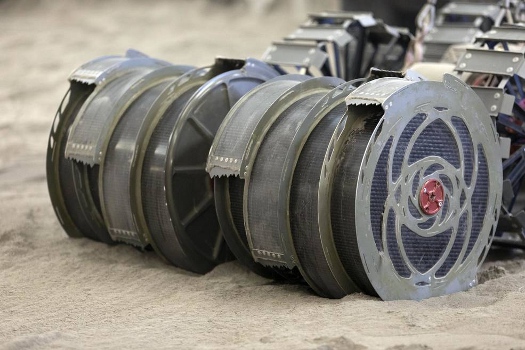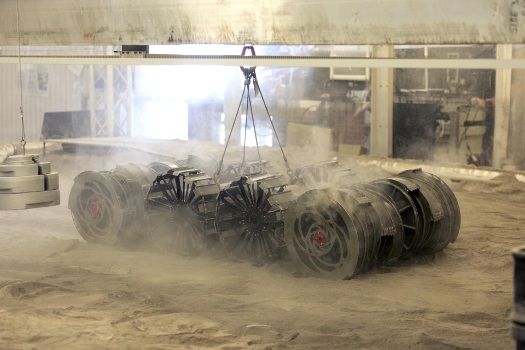 |
| March 24, 2020 | Volume 16 Issue 12 |
Designfax weekly eMagazine
Archives
Partners
Manufacturing Center
Product Spotlight
Modern Applications News
Metalworking Ideas For
Today's Job Shops
Tooling and Production
Strategies for large
metalworking plants
NASA needs your help designing a Moon digger

A close-up view of the bucket drums on the Regolith Advanced Surface Systems Operations Robot (RASSOR) in the regolith bin inside Swamp Works at NASA's Kennedy Space Center in Florida on June 5, 2019. [Credits: NASA/Kim Shiflett]
By Linda Herridge, NASA's John F. Kennedy Space Center
Digging on the Moon is a hard job for a robot. It has to be able to collect and move lunar soil, or regolith, but anything launching to the Moon needs to be lightweight. The problem is that excavators rely on their weight and traction to dig on Earth. NASA has a solution, but it is looking for ideas to make it better. Once matured, robotic excavators could help NASA establish a sustainable presence on the Moon under the Artemis lunar exploration program, a few years after landing astronauts on the surface.
Engineers have tested various configurations of a Moon-digging robot called RASSOR (short for Regolith Advanced Surface Systems Operations Robot) in a large lunar simulant sand box at NASA's Kennedy Space Center in Florida. Now, NASA is asking the public to help design a new bucket drum, the portion of the robot that captures the regolith and keeps it from falling out. The regolith can then be transported to a designated location where reverse rotation of the drum allows it to fall back out.
RASSOR's current bucket drums are hollow cylinders positioned on either end of the robot, with scoops around the circumference of the cylinders. The robot digs in opposing ends toward the other, which balances the excavation forces and makes it easier to dig.
NASA's RASSOR Bucket Drum Design Challenge is open through April 20, 2020. The challenge, sponsored by NASA's Space Technology Mission Directorate (STMD), seeks a better shape for RASSOR's bucket drum and baffling, or sheet metal inside of it that can capture and hold more regolith. GrabCAD, a website where people can join and post 3D models of almost anything, is hosting the challenge, and eligible individuals with an idea can submit original designs that have not been previously published, exhibited, or put into production for this important part of RASSOR.
"We've held challenges on GrabCAD in the past, and they were very successful," said Jason Schuler, a robotics engineer in the Exploration Research and Technology Programs at Kennedy. "As a repository for computer-aided design, the platform helps us reach professional designers, engineers, manufacturers, and students outside of the space industry who may have an idea that could benefit NASA."
Successful designs for this competition will have a fill ratio of higher than 50 percent, which means the design's interior volume will be more than half full with regolith when it reaches the maximum amount it can hold.
"With RASSOR, we're no longer relying on the traction or the weight of the robot. It is possible to excavate on the Moon or Mars with a really lightweight robot," Schuler said. "RASSOR is excavation and transportation all in one, but we'd like to improve the design."

A team from the Granular Mechanics and Regolith Operations Lab tests the Regolith Advanced Surface Systems Operations Robot (RASSOR) in the regolith bin inside Swamp Works at NASA's Kennedy Space Center in Florida on June 5, 2019. Tests use a gravity-assist offload system to simulate reduced gravity conditions found on the Moon. [Credits: NASA/Kim Shiflett]
At the end of the competition, the design entries will be judged on a set of criteria, including width of the scoops, bucket drum mass, diameter and length, volume of regolith captured, and practicality of the design. In addition to the CAD files, entries must include a short description of how the design works.
A total of $7,000 will be awarded for the top five submissions. For more information about prize amounts and how to enter, visit: https://grabcad.com/challenges/nasa-regolith-advanced-surface-systems-operations-robot-rassor-bucket-drum-design-challenge.
The challenge is funded by NASA's Lunar Surface Innovation Initiative within STMD, which champions technologies needed to live on and explore the Moon. NASA Tournament Lab, part of STMD's Prizes and Challenges program, manages the challenge. The program supports the use of public competitions and crowdsourcing as tools to advance NASA R&D and other mission needs.
Artemis includes sending a suite of new science instruments and technology demonstrations to study the Moon, landing the first woman and next man on the lunar surface by 2024, and establishing a sustained presence by 2028. The agency will leverage its Artemis experience and technologies to prepare for the next giant leap: sending astronauts to Mars. RASSOR is a technology project being developed by Swamp Works at Kennedy that could be used on the Moon or Mars.
Published March 2020
Rate this article
View our terms of use and privacy policy
